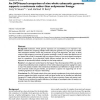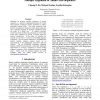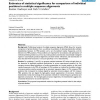820 search results - page 23 / 164 » Using Multiple Alignments to Improve Gene Prediction |
BMCBI
2008
13 years 7 months ago
2008
Background: The identification of transcription factor binding sites is difficult since they are only a small number of nucleotides in size, resulting in large numbers of false po...
BMCBI
2004
13 years 7 months ago
2004
Background: Eukaryotic whole genome sequences are accumulating at an impressive rate. Effective methods for comparing multiple whole eukaryotic genomes on a large scale are needed...
AAAI
2004
13 years 8 months ago
2004
Obtaining an accurate multiple alignment of protein sequences is a difficult computational problem for which many heuristic techniques sacrifice optimality to achieve reasonable r...
BIOINFORMATICS
2005
13 years 7 months ago
2005
: Recent advances in gene sequencing have provided complete sequence information for a number of genomes and as a result the amount of data in the sequence databases is growing at ...
BMCBI
2004
13 years 7 months ago
2004
Background: Profile-based analysis of multiple sequence alignments (MSA) allows for accurate comparison of protein families. Here, we address the problems of detecting statistical...



